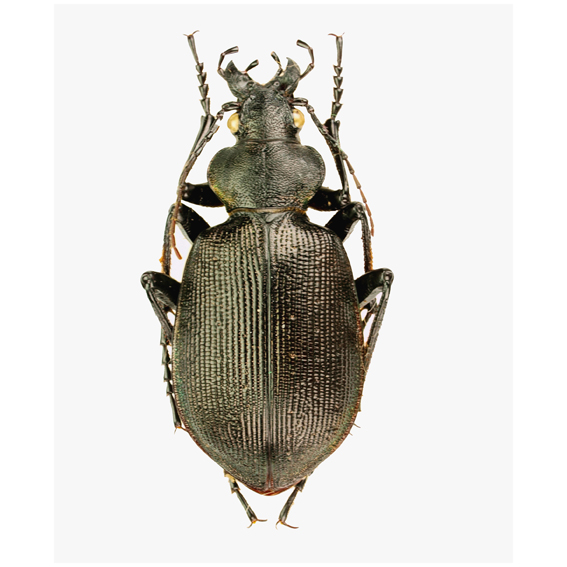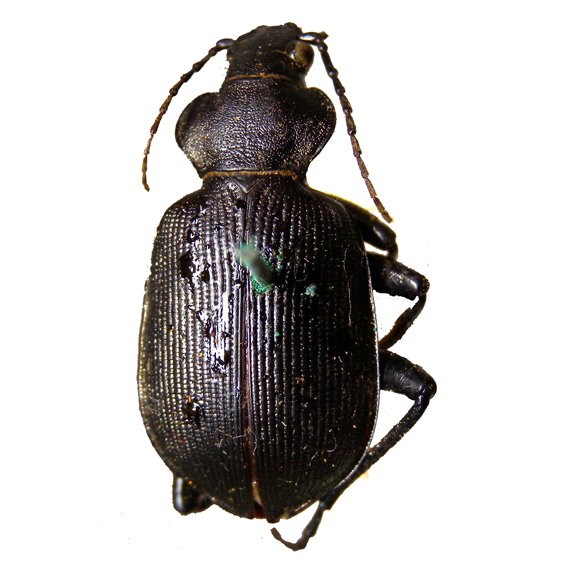Calosoma (Calosoma) beesoni Andrewes, 1919
Calosoma beesoni Andrewes, 1919: 290 (described from: Mandali) holotype ♀ in Natural History Museum, London [examined]
Calosoma (Calosoma) beesoni, Breuning 1927: 175
Calosoma beesoni, Andrewes 1929: 52
Calosoma (Callipara) beesoni Lapouge, 1932: 403
Calosoma (Calosoma) beesoni Jeannel, 1940: 84
Calosoma (Calosoma) sycophanta ssp beesoni, Deuve 1997: 53
Calosoma (Calosoma) himalayanum, Lorenz 2005: 68
Length 24-25 mm. The body shape of C. beesoni reveals an evident kinship with C. sycophanta . The shape of the pronotum is quite similar, decidedly transverse and narrowed behind, but it is easy to distinguish the two species because in C. beesoni the lateral margin is less elevated, as it happens in C. maximoviczi and in C. himalayanum, to which C. beesoni superficially resembles in many other respects.
The similar apparence led to propose the synonymy of C. beesoni with C. himalayanum (Deuve, 1997: 186) and subsequently has implied that C. beesoni disappeared from the catalogues (Lorenz, 2005: 68).
However, despite the aforementioned opinion of Deuve, that the two taxa just differ in colour, C. beesoni is still distinguishable because of the characters already highlighted by Andrewes (1929: 51), namely: the head and pronotum that appear punctured coarsely; the elytra, that are slightly flattened and enlarged in their posterior third and faintly serrate behind shoulders; the conspicuously elevated elytral sculpture with imbricate intervals.
The upper side of the body is black, having a bronze or, rarely, a bluish lustre that can be appreciated with some attention.
C. beesoni is restricted to north-eastern India (Himachal Pradesh) and Pakistan (Khyber Pakhtunkhwa).
Examined specimens and literature’s data
India. Himachal Pradesh: Mandali 2800m (type BMNH), Simla, Kalela forest (MNHN); Jammu and Kashmir: Lolab Valley (Pratap Singh & al., 1989), Bihar: Kathian (Breuning, 1927: 176); Uttarakhand: Dehradun (MNHN), Thano, Molta, Bodyar (Breuning, 1927: 176)
Pakistan. Khyber Pakhtunkhwa: Swat valley 2450 m (SB), Miandam (NMB)
Notes: The species is named after Cyril Frederick Cherrington Beeson (1889–1975) an English entomologist and forest conservator who worked in India.
C beesoni has been observed during daytime as predaceous on Ectropis deodarae, the defoliator of Cedrus deodara (Andrewes, 1929: 53). Active individuals have been found at the beginnig of the raining season, in May and June
The description of the larva is due to Gardner (1927: 61).
 Andrewes, 1919 Pakistan, North-West Frontier province, Swat valley, Miandam 2450m., 6.79, Lassalle dt. |
 Andrewes, 1919 Pakistan, North-West Frontier province, Swat valley, Miandam 2450m., 6.79, Lassalle dt |
 Andrewes, 1919 India, Himachal Pradesh, Mandali 8500', Chakrata Diu, 5.I.1915, CFC Beeson, (Typus) (British Museum of Natural History, London) |